Work = Force x Distance (at least to start with) W = F s |
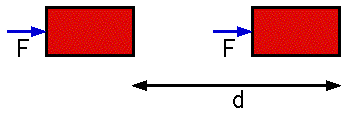 |
If the force is at an angle to the displacement, then it will be less effective in causing accn. Hence define
W = F s cos(θ)
Note you do no work to a bucket of water if
|
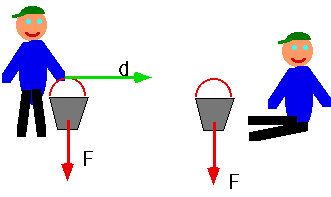 |
Note that we have multiplied two vectors together here
Define scalar product of two vectors
W = F.s
to mean
W = \color{red}{{\vec F}}x(component of \color{red}{{\vec s}} in direction of \color{red}{{\vec F}})
W = Fs cos(θ)
(note scalar product is a scalar!)
Note that if the displacement is opposite in direction to the force, the work is negative Done properly:: both Force \color{red}{{\vec F}} and displacement \color{red}{{\vec d}} are vectors: for any vectors \color{red}{\vec F.\vec s = \left| {\vec F} \right|.\left| {\vec s} \right|\cos \left( \theta \right) = Fs\cos \left( \theta \right)} so (e.g.) \color{red}{ \vec F.\vec F = F^2 } so
|
e.g. suppose
\color{red}{
\begin{array}{l}
\vec s = 3\hat i + 4\hat j \\
\vec F = 5\hat i + 12\hat j \\
\end{array}}
What is s?
|
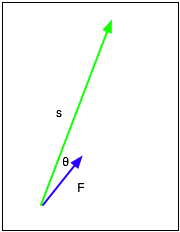 |
|
e.g. suppose
\color{red}{
\begin{array}{l}
\vec s = 3\hat i + 4\hat j \\
\vec F = 5\hat i + 12\hat j \\
\end{array}}
What is F?
|
 |
|
e.g. suppose
\color{red}{
\begin{array}{l}
\vec s = 3\hat i + 4\hat j \\
\vec F = 5\hat i + 12\hat j \\
\end{array}}
What is \color{red}{\vec F.\vec s}
|
 |
|
e.g. suppose
\color{red}{
\begin{array}{l}
\vec s = 3\hat i + 4\hat j \\
\vec F = 5\hat i + 12\hat j \\
\end{array}}
So
|
 |
e.g. Lifting an object, mass m through height h
|
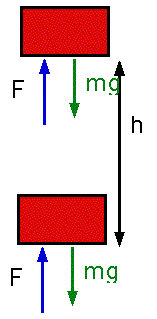 |
Assuming the block is moving at uniform velocity,
F = mg
Work is only useful because it lets us introduce a new idea called Energy.
Kinetic Energy
| defined to be | T = 1/2 m v2 |
for a particle with mass m, vel v.
| If we have a constant accn. | v2 = v02 + 2 a s |
mult. both sides by 1/2m gives
1/2mv2 = 1/2mv02 + m a s
but
ma = F
so this can be rewritten
Fs = 1/2mv2 - 1/2mv02
Work done = change in kinetic energy. Watch the animation!
This result is completely general: We have proved it for constant acceleration in 1-D, but it works for any force in 3-D.
Conservative Forces:
| Fortunately for a lot of forces, the W.D. depends only on the endpoints. | 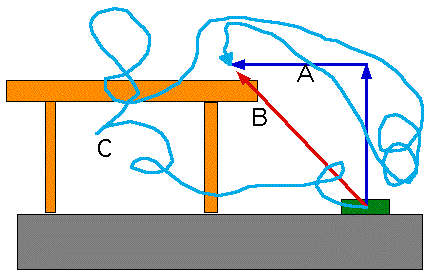 |
| e.g. along route A | 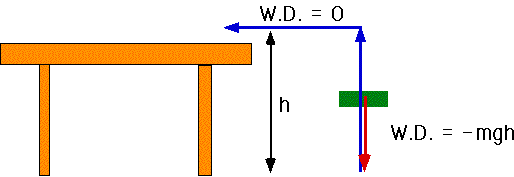 |
| e.g. along route B | 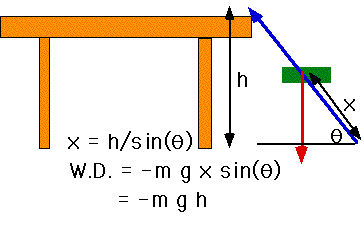 |
| Complicated paths can be simplified. | 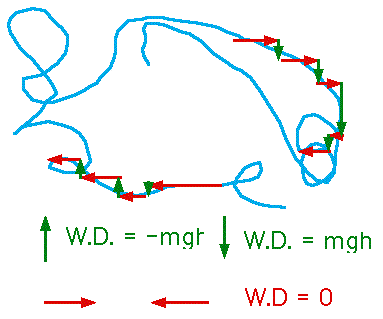 |
Whatever the path, the W.D. by gravity is the same
| W.D. by gravity | = -mg(h-h0) |
where h0,h are the starting and ending position respectively
Potential Energy
Which leads us to Potential Energy: If W.D. is independent of the path, then Force is conservative and we can define Change in P.E. = -(work done along path)
e.g. Gain in P.E. by raising an object a height = mgh
So What?
Since
W.D. = Change in K.E.
and
W.D. = - Change in P.E.
Then
Change in K.E. + Change in P.E. = 0 i.e.
Total energy = P.E.+ K.E.= constant
Watch the animation!
Note that the force would be very complicated in this case, so one couldn't actually solve via F = ma
Units
Need a new unit for energy
[1/2mv2] = M L2T-2 = kg m2s-2
1 Joule= 1 kg m2s-2
(Joule originated study of heat energy ⇒ mechanical energy)
Another very useful unit of energy is the Electron Volt (eV)
1 eV = 1.602x10-19 J
(Origin later)
Conservation of Energy
A very important idea that we will return to again and again:
If the forces are conservative, then total (mechanical) energy will be conserved: it can be transformed from one form to another. (P.E. ⇔K.E.)
Later will see that energy is always conserved, but we need to introduce more kinds:
Heat⇔chemical ⇔ potential ⇔ nuclear ⇔kinetic
| e.g. What should the world pole vault record be? (5.8 m at present). |  |
Assume that the vaulter runs at 10 ms-1, and his c.o.m. is 1 m. above the ground
Note (Very Important)
Only Differences in P.E. are meaningful
δU = mg(h-h0)
It doesn't matter where we choose h to be measured from
How do I decide if I have a conservative force?
If you can get the energy you put into the system back, it's conservative. e.g. all fundamental forces (gravitational, electromagnetic, nuclear..) or..........
If the work done is independent of the path, then if one goes round a closed path which returns to the starting point, the W.D. is zero
Hence friction cannot be a conservative force
W.D. = - 4 d F |

|
In general, Work-energy theorem has to be changed if we have non-conservative forces
Total work = change in K.E. (always)
work done by conservative forces + work done by non-conservative forces = - change in P.E. + WDnc
WDnc= δT + δU
e.g A 70 kg skier goes down a slope with a vertical drop of 100m and a length l=.5 km. If his terminal velocity is zero, what is the average friction? What would the speed be if l = 250m?
Perpetual Motion Machines
| We would be able to arrange for a complicated system of forces to keep things moving forever. | 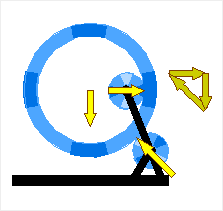 |
| which turns for ever |  |
| Or another variety |  |
| which also turns for ever |  |
| and here is a modern version of the |  |
| overbalancing wheel |  |
Conservation of energy tells you not even to try! (and the US patent office requires a working model of a perpetual motion machine...!). However, that doesn't stop people from trying.. These come from two fascinating sites. See here (by R Woods) and here (by Eric Dennis).
Gravitational P.E.
We have to use calculus!
| We have
\color{red}{
F = - \frac{{GMm}}{{r^2 }}}
(the minus sign gets the direction correct) |
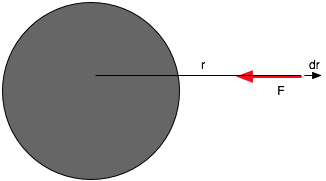 |
- Suppose we move it the point a little further (δr) from the earth:
-
\color{red}{ W.D. = dW = \vec F.\delta \vec r = - \frac{{GMm}}{{r^2 }}\delta r}
- \color{red}{ W.D. = \sum\limits_{}^{} { - \frac{{GMm}}{{r^2 }}\delta r \Rightarrow } - \int {\frac{{GMm}}{{r^2 }}dr} }
- Change in P.E. = - W.D.
-
For gravity in general, (not close to earth's), can use the freedom to measure from any particular point to set U(∞) = 0
Then we get
- \color{red}{ U\left( r \right) = \int_r^\infty {\frac{{GMm}}{{r^2 }}dr} = - \frac{{GMm}}{r}}
U(h) = mgh
| but................ In fact the slopes are the same near the surface of the earth |
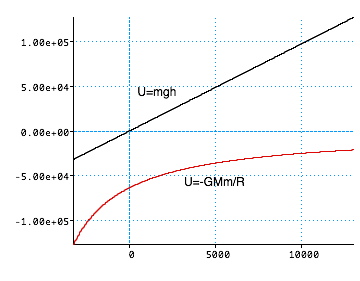
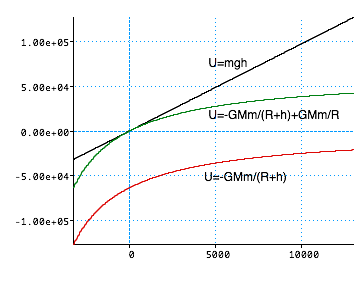
|
Satellite in orbit at distance r from earth.
This is quite general: a system of two or more particles bound together will have negative energy. Also
K.E. = - 1/2 P.E.
Escape Velocity How hard would you need to throw something so that it never came back?
- At the earth's surface,
- At ∞, P.E. = 0, so want K.E. = 0 as well
-
Remember T.E. = P.E. + K.E. = constant \color{red}{ \frac{1}{2}mv^2 = \frac{{GMm}}{r} \Rightarrow v = \sqrt {\frac{{2GMm}}{r}} }
-
e.g. for the earth: R = 6500 km g = 9.8 ms-2
vescape
-
=???
- What does this mean?
- Warning: this argument is totally dishonest! We lucked into the correct answer!
General strategy
General strategy for all Energy problems
- Define the system and draw a diagram
- Work-energy can be used if you are asked for (e.g.) the final velocity. It cannot be used (usually) if you are asked for times.
- Decide if all the forces are conservative (More difficult if they are not)
- Choose a zero-point for P.E.: usually where you start from (e.g uncompressed spring) but can be r = ∞ for grav. problem.
- If no friction, then use
(PE + KE)start = (PE + KE)end
If friction
W.Dfriction= δPE + δKE
|
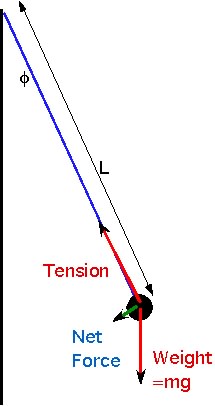 |
Power
Rate of doing work Unit: 1 watt = 1 Joule/sec = 1 kg m2 s-3
e.g. a man climbs a 3 flights of stairs (4 m each) in 6 s. If his mass is 70 kg what is his power output?
Unit is rather small: often use 1 Horse-power = 746 watts
- lightbulb consumes 10-150 W
- Home-heating ~ 1-5 kW
- Output of power-station ~1GW = 109W
- Car engine ~ 10 kW
- Note (very confusingly) 1 kilo-Watt hour (kWh) is unit of energy
1 kWh = 60x60x1000 J = 3.6 MJ Unit that electrical energy is sold in
I was stupid enough to live in a farm-house with a drilled well 460 ft. deep
If I have a 3/4 h.p. motor, can I get a bath?
In limit, Instantaneous power
P = δW
δt
An alternative way of writing this:
δW = F.δs
so
δW = F.δs = F.v δt δt
so...
Power = Force x Velocity
e.g. a car has a max. power output of 30 kW, and the air resistance is given by
F = 1/2 cρAv2.
- What is its maximum speed, if c = 0.5, A = 2m2 and ρ = 1.3?
- How much power is used at 80 km/hr?
